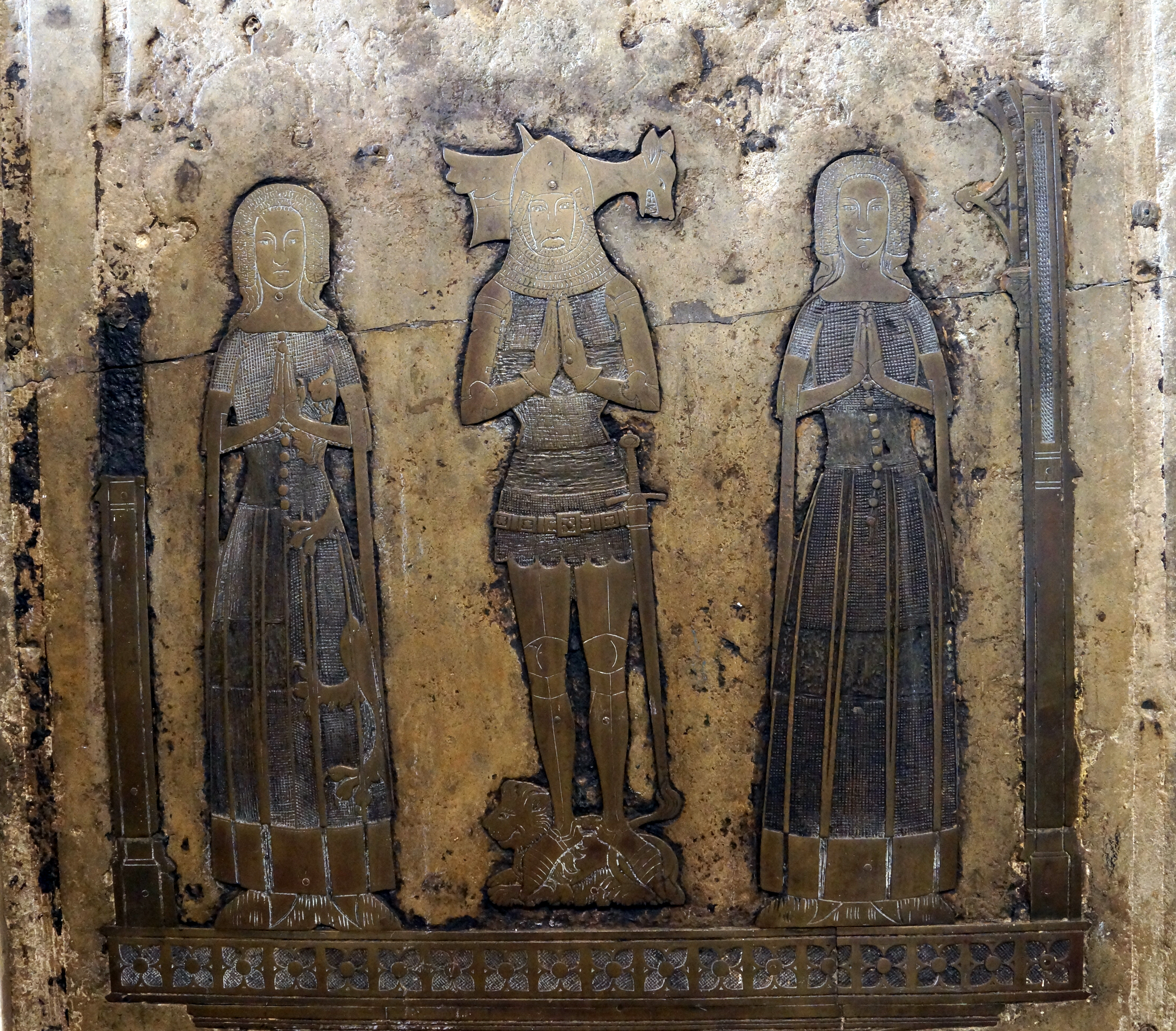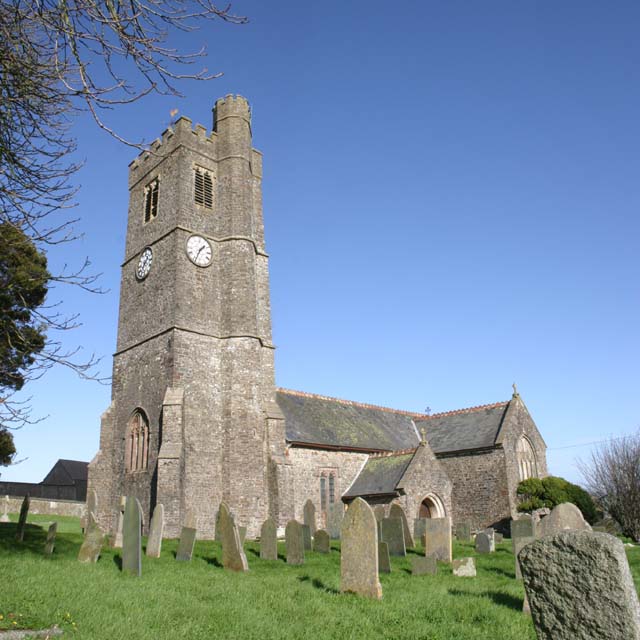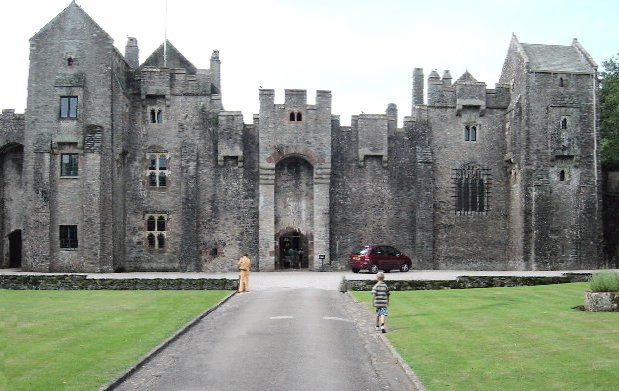|
Honor Grenville, Viscountess Lisle
Honor Grenville, Viscountess Lisle (c. 1493–1495Byrne, vol.1, p. 305, Honor's birthyear was estimated at 1493–95 – 1566) was a Cornish lady whose domestic life from 1533 to 1540 during the reign of King Henry VIII is exceptionally well-recorded, due to the survival of the Lisle Papers in the National Archives, the state archives of the UK. Origins Honor was a daughter of Sir Thomas Grenville (died 1513) of Stowe in the parish of Kilkhampton, Cornwall, and lord of the manor of Bideford in North Devon, by his wife Isabella Gilbert, a daughter of Otes Gilbert (1417–1492) of ComptonVivian, p.405 in the parish of Marldon, Devon (whose effigy survives in Marldon Church). Marriages and children She married twice: *Firstly to Sir John Basset (1462–1528) of Umberleigh in the parish of Atherington in Devon. At her father's death in 1492 Honor was his only daughter by his first wife (the heiress Alicia Mules/Moels) who was still unmarried, and in his will, Sir ... [...More Info...] [...Related Items...] OR: [Wikipedia] [Google] [Baidu] |
Monumental Brass
A monumental brass is a type of engraved sepulchral memorial, which in the 13th century began to partially take the place of three-dimensional monuments and effigies carved in stone or wood. Made of hard latten or sheet brass, let into the pavement, and thus forming no obstruction in the space required for the services of the church, they speedily came into general use, and continued to be a favourite style of sepulchral memorial for three centuries. In Europe Besides their great value as historical monuments, monumental brasses are interesting as authentic contemporary evidence of the varieties of armour and costume, or the peculiarities of palaeography and heraldic designs, and they are often the only authoritative records of the intricate details of family history. Although the intrinsic value of the metal has unfortunately contributed to the wholesale spoliation of these interesting monuments, they are still found in remarkable profusion in England, and they were at one time ... [...More Info...] [...Related Items...] OR: [Wikipedia] [Google] [Baidu] |
Stowe House, Kilkhampton
Stowe House in the parish of Kilkhampton in Cornwall, England, UK, was a mansion built in 1679 by John Grenville, 1st Earl of Bath (1628–1701) and demolished in 1739. The Grenville family were for many centuries lords of the manor of Kilkhampton, which they held from the feudal barony of Gloucester, as they did their other principal seat of nearby Bideford in Devon. It is possible that the family's original residence at Kilkhampton was Kilkhampton Castle, of which only the groundworks survive, unusual in that it had a motte with two baileys. History ''(For descent of Grenville family of Stowe see: Manor of Bideford)'' The Grenville family's earliest seat was in their manor of Bideford in Devon, but from the 14th century they were also seated at Stowe. The last house on the site was built in about 1675 by John Granville, 1st Earl of Bath (1628–1701), created in 1660 in recompense for his great assistance in the Restoration of King Charles II, Baron Granville, Viscount ... [...More Info...] [...Related Items...] OR: [Wikipedia] [Google] [Baidu] |
Mistress (lover)
A mistress is a woman who is in a relatively long-term sexual and romantic relationship with a man who is married to a different woman. Description A mistress is in a long-term relationship with her attached mister, and is often referred to as "the other woman". Generally, the relationship is stable and at least semi-permanent, but the couple does not live together openly and the relationship is usually, but not always, secret. There is often also the implication that the mistress is sometimes "kept"i.e. her lover is contributing to her living expenses. A mistress is usually not considered a prostitute: while a mistress, if "kept", may, in some sense, be exchanging sex for money, the principal difference is that a mistress has sex with fewer men and there is not so much of a direct ''quid pro quo'' between the money and the sex act. There is usually an emotional and possibly social relationship between a man and his mistress, whereas the relationship between a prostitute and ... [...More Info...] [...Related Items...] OR: [Wikipedia] [Google] [Baidu] |
Anne Bassett
Anne Basset (1520 – before 1558) was an English lady-in-waiting of the Tudor period, reputed to have been the mistress of King Henry VIII. Biography Anne was born in 1520, the fourth child of Sir John Basset and Honor Grenville (daughter of Sir Thomas Grenville of Stowe in Kilkhampton, Cornwall and his wife Isabella). As her father died when she was young, Anne was brought up by her mother and stepfather, Arthur Plantagenet, Lord Lisle, in the English enclave of Calais. Lord Lisle was the illegitimate son of Edward IV of England, and thus Henry VIII's uncle. Court career Anne's mother, had attempted to secure a place for her two daughters (Anne and her sister Katharine Basset) in the service of Queen Anne Boleyn several times, but to no avail. She persisted in her efforts to secure them positions and eventually, after sending a large consignment of quails to Anne's successor, Queen Jane Seymour, the latter relented. She allowed Lady Lisle to send her daughters but warned ... [...More Info...] [...Related Items...] OR: [Wikipedia] [Google] [Baidu] |
Katherine Basset
Katharine Basset (c. 1522 – after 1558, occasionally misnamed "Elizabeth") was an English gentlewoman who served at the court of King Henry VIII, namely in the household of Queen Anne of Cleves, and was briefly jailed for speaking against him. Three of her letters to her mother Honor Grenville survive in the Lisle Papers. Life Basset was the second daughter of Sir John Basset (1462–1528), KB, of Tehidy in Cornwall and Umberleigh in Devon (Sheriff of Cornwall in 1497, 1517 and 1522 and Sheriff of Devon in 1524) by his second wife, Honor Grenville (died 1566; later Viscountess Lisle), a daughter of Sir Thomas Grenville (died 1513) of Stowe in the parish of Kilkhampton, Cornwall, and lord of the manor of Bideford in North Devon, Sheriff of Cornwall in 1481 and in 1486. Her siblings were: Philippa Basset (born 1516), eldest daughter; John Basset (1518–1541), his father's eldest son and heir, a lawyer and servant of Thomas Cromwell who died aged 23; Anne Basset (born 15 ... [...More Info...] [...Related Items...] OR: [Wikipedia] [Google] [Baidu] |
Monumental Brass
A monumental brass is a type of engraved sepulchral memorial, which in the 13th century began to partially take the place of three-dimensional monuments and effigies carved in stone or wood. Made of hard latten or sheet brass, let into the pavement, and thus forming no obstruction in the space required for the services of the church, they speedily came into general use, and continued to be a favourite style of sepulchral memorial for three centuries. In Europe Besides their great value as historical monuments, monumental brasses are interesting as authentic contemporary evidence of the varieties of armour and costume, or the peculiarities of palaeography and heraldic designs, and they are often the only authoritative records of the intricate details of family history. Although the intrinsic value of the metal has unfortunately contributed to the wholesale spoliation of these interesting monuments, they are still found in remarkable profusion in England, and they were at one time ... [...More Info...] [...Related Items...] OR: [Wikipedia] [Google] [Baidu] |
Marriage Settlement
A marriage settlement in England was a historic arrangement whereby, most commonly and in its simplest form, a trust of land or other assets was established jointly by the parents of a bride and bridegroom. The trustees were established as legal owners of the assets, and the bride and bridegroom as beneficial owners of the assets during their lifetimes, and after their deaths, beneficial ownership would descend to one or more of the children of the union. The marriage settlement should not be confused with the modern prenuptial agreement, which is concerned mainly with the division of assets after divorce. Such settlements were also commonly made in the British colonies in North America, among families with assets to protect. Purposes It was a means of ensuring the proper use of a dowry provided by a bride's father to be used for his daughter's financial support throughout her married life and into her widowhood, and also a means by which the bride's father was able to obtain from t ... [...More Info...] [...Related Items...] OR: [Wikipedia] [Google] [Baidu] |
Atherington, Devon
Atherington is a village and civil parish in the North Devon district of Devon, England, about 8 miles south of Barnstaple. According to the 2001 census the parish had a population of 391. The church of St Mary is Perpendicular and was restored by J. L. Pearson in 1884. The church has a screen and gallery dating back 400 years, as well as a roodloft stairway of the same age. In the loft are Elizabethan heraldic panels. There is also a 15th-century screen across the chancel, and a font of the same period. The north aisle part of the screen retains the original canopy and as such is unique in Devon (it was carved by two craftsmen from Chittlehampton c. 1540). The chancel section was brought here from Umberleign c. 1800. The benches have elaborate carved ends, and there is some very old stained glass.Betjeman, John, ed. (1968) ''Collins Pocket Guide to English Parish Churches; the South''. London: Collins; p. 159 Umberleigh railway station is located in the nearby village of Umbe ... [...More Info...] [...Related Items...] OR: [Wikipedia] [Google] [Baidu] |
Umberleigh
Umberleigh is a former large manor within the historic hundred of (North) Tawton, but today a small village in North Devon in England. It used to be an ecclesiastical parish, but following the building of the church at Atherington it became a part of that parish. It forms however a part of the civil parish of Chittlehampton, which is mostly located on the east side of the River Taw. The manor of Umberleigh, which had its own entry in the Domesday Book of 1086, was entirely situated on the west side of the River Taw and was centred on the Nunnery which was given by William the Conqueror to the Holy Trinity Abbey in Caen, Normandy. The site was later occupied by the manor house of Umberleigh, the present Georgian manifestation of which, a large and grand farmhouse, is known as "Umberleigh House". Next to the manor house in about 1275 was founded Umberleigh Chapel, now a ruin the single remaining wall of which forms the back wall of a farm implements shed. Descent of the m ... [...More Info...] [...Related Items...] OR: [Wikipedia] [Google] [Baidu] |
Nikolaus Pevsner
Sir Nikolaus Bernhard Leon Pevsner (30 January 1902 – 18 August 1983) was a German-British art historian and architectural historian best known for his monumental 46-volume series of county-by-county guides, ''The Buildings of England'' (1951–74). Life Nikolaus Pevsner was born in Leipzig, Saxony, the son of Anna and her husband Hugo Pevsner, a Russian-Jewish fur merchant. He attended St. Thomas School, Leipzig, and went on to study at several universities, Munich, Berlin, and Frankfurt am Main, before being awarded a doctorate by Leipzig in 1924 for a thesis on the Baroque architecture of Leipzig. In 1923, he married Carola ("Lola") Kurlbaum, the daughter of distinguished Leipzig lawyer Alfred Kurlbaum. He worked as an assistant keeper at the Dresden Gallery between 1924 and 1928. He converted from Judaism to Lutheranism early in his life. During this period he became interested in establishing the supremacy of German modernist architecture after becoming aware of Le ... [...More Info...] [...Related Items...] OR: [Wikipedia] [Google] [Baidu] |
Marldon
Marldon is a village in the South Hams in Devon, United Kingdom, to the north-west of Paignton. It is the most northeasterly Civil Parish in the South Hams and includes the village of Compton with Compton Castle. Beacon Hill transmitting station is on the highest point in the parish. History Church records date back to 1598. The parish was in the Haytor Hundred. Marldon was a small village until the 1960s when major residential development took place. Marldon is known locally for its Apple Pie fair which originated in the nineteenth century and was revived in 1958. Amenities Marldon is an active community with many clubs and groups meeting regularly. Two walking trails pass through the village: * John Musgrave Heritage Trail, a 35-mile route around Torbay * Totnes-Torquay Trail Notable former residents * Robert Adams (1810–1870), inventor of the double-action revolver * Gilberts of Compton, including the explorer Sir Humphrey Gilbert (1539-1583) * Elizabeth Goudge (1900– ... [...More Info...] [...Related Items...] OR: [Wikipedia] [Google] [Baidu] |
Compton Castle
Compton Castle in the parish of Marldon in Devon, is a fortified manor house in the village of Compton (formerly "Compton Pole"), about west of Torquay on the southern coast of Devon, England (). The estate was home to the families of Compton, de la Pole, Doddiscombe, Gilbert and Templer. The castle has been home to the Gilbert family for most of the time since it was built. Listed as a Grade 1 set of buildings, it has been a National Trust property since 1951. History The castellated house was the seat of Sir Maurice de la Pole in the reign of King Henry II (1154–1189), after which family the manor was known as Compton Pole when it came into the hands of Sir Peter Compton. The original undefended manor house was built in the mid-14th century and consisted of a hall flanked by solar and service rooms at each end. These were rebuilt in the later Middle Ages. The fortress-like front was added in about 1520 by John Gilbert. The central hall was in ruins by the 18th century, b ... [...More Info...] [...Related Items...] OR: [Wikipedia] [Google] [Baidu] |

.jpg)




